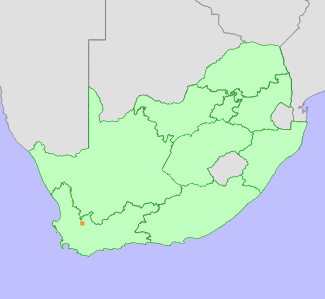|
Scientific Name | Aspalathus eriocephaloides C.H.Stirt. & Muasya |
Higher Classification | Dicotyledons |
Family | FABACEAE |
National Status |
Status and Criteria | Vulnerable D1 |
Assessment Date | 2021/06/29 |
Assessor(s) | N.A. Helme |
Justification | A range-restricted species with an extent of occurrence (EOO) and area of occupancy (AOO) of 4 km². It has no known threats. The populations is estimated to have less than 1000 plants, and is therefore listed as Vulnerable under criterion D1. |
Distribution |
Endemism | South African endemic |
Provincial distribution | Western Cape |
Range | This species has a very restricted distribution in the Swartruggens Mountains of the Western Cape Province, South Africa. |
Habitat and Ecology |
Major system | Terrestrial |
Major habitats | Swartruggens Quartzite Fynbos |
Description | This habitat specialist occurs on fairly hard sandy soils, at elevations of 1200 m above sea level. |
Threats |
| There are no threats to this species, and it is unlikely to be threatened by habitat loss as it occurs in a private nature reserve. The aridity of the habitat also means that it is not suitable for cultivation. |
Population |
It was collected for the first time by N. Helme in 2014, and is likely to be rare and localized. This species is known from one population, and it is estimated to have less than 1000 plants. The population is currently stable.
|
Population trend | Stable |
Bibliography |
Stirton, C.H. and Muasya, A.M. 2016. Seven new species and notes on the genus Aspalathus (Crotalarieae, Fabaceae). South African Journal of Botany 104:35-46.
|
Citation |
| Helme, N.A. 2021. Aspalathus eriocephaloides C.H.Stirt. & Muasya. National Assessment: Red List of South African Plants version 2024.1. Accessed on 2025/10/26 |
 Comment on this assessment
Comment on this assessment

